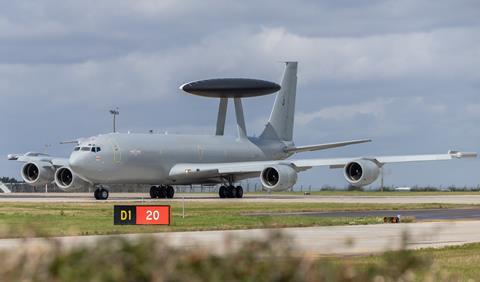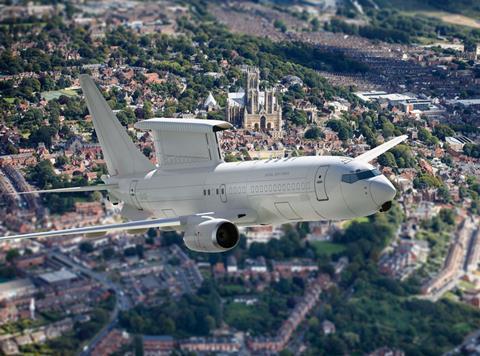The UK will use its position within the multinational NATO Airborne Early Warning and Control (AEW&C) Force to cover for the retirement of its remaining Boeing E-3D Sentry aircraft later this year, with their replacements not due to arrive until 2023.
Three of the 707-based surveillance aircraft remain in Royal Air Force (RAF) service, but their departure was announced in the Ministry of Defence’s (MoD’s) Defence in a competitive age publication on 22 March.

“We will retire the E-3D Sentry in 2021, as part of the transition to the more modern and more capable fleet of three [Boeing] E-7A Wedgetails in 2023,” the MoD said in its review of spending priorities until 2025.
“Further decisions on the exact date of retirement will come later,” the MoD tells FlightGlobal. The RAF on 29 March marked the 30th anniversary of the E-3D’s first flight in its service.
With the departure of the E-3Ds, the UK will face a roughly two-year gap in its domestic provision of airborne early warning services. “We remain a full member of the NATO AEW&C Force, which will provide cover when requested,” the MoD says.
In its 2015 Strategic Defence and Security Review, the MoD said it would upgrade the Sentry fleet, extending its use until 2035. However, it stepped back from this approach, and in March 2019 signed a £1.5 billion ($2 billion) contract to acquire five E-7As, for use from 2023.
Under that deal, it ordered three new-build 737NGs, plus a pair of secondhand examples, for conversion to the AEW&C configuration. This adds a Northrop Grumman surveillance radar atop the narrowbody’s fuselage, and onboard mission system operator stations.
The first secondhand aircraft arrived at conversion provider STS Aviation Services’ Birmingham airport facility in the UK in January.
However, the MoD’s four-year plan also confirmed a decision to reduce the Wedgetail fleet size from five to three aircraft. This step is understood to involve cancelling orders for two new-build airframes.

“Wedgetail will provide a step-change in AEW&C capability from where we are now, and it will have better availability than the E-3,” the MoD says. Once fielded, the new aircraft also will “offer connectivity and information-sharing capabilities currently unavailable with NATO”.
The MoD notes: “Our future air surveillance capability will be undertaken by a mix of technologies – we will not rely solely on aircraft as we did in the past.” For example, the defence review pledges to develop an intelligence, surveillance and reconnaissance satellite constellation, with work due to begin next year.
“With other emerging technologies, three [E-7] aircraft will be able to deliver the operational output,” it concludes.
Based at RAF Waddington in Lincolnshire, the Sentry fleet originally totalled seven airframes. Cirium fleets data shows that the remaining CFM International CFM56-engined E-3Ds are aged between 29 and 31 years old.
Operations with the replacement E-7As will be conducted from RAF Lossiemouth in Scotland – also the home for the service’s 737NG-based P-8A Poseidon MPA1 maritime patrol aircraft. The service has so far received five of an eventual nine examples of the type.
The UK will follow the air forces of Australia (with six examples), South Korea (4) and Turkey (4) in fielding the Wedgetail platform. The type also could be a candidate if the US Air Force moves to replace its E-3 inventory.


























